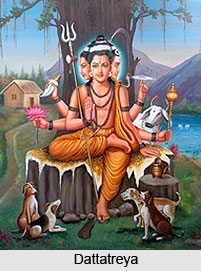 Dattatreya is considered by Hindus to be the supreme as he includes the trio of Lord Brahma, Lord Vishnu and Lord Shiva. He is worshipped in a diversified manner by various sects of the Hindus. He is considered more as a generous God. He is the author of the Tripura Rahasya which was a treatise on Advaita Vedanta. Dattatreya is considered as one of the oldest deities as he is referred in epics of Mahabharata and Ramayana. He embraced all spiritual paths.
Dattatreya is considered by Hindus to be the supreme as he includes the trio of Lord Brahma, Lord Vishnu and Lord Shiva. He is worshipped in a diversified manner by various sects of the Hindus. He is considered more as a generous God. He is the author of the Tripura Rahasya which was a treatise on Advaita Vedanta. Dattatreya is considered as one of the oldest deities as he is referred in epics of Mahabharata and Ramayana. He embraced all spiritual paths.
Anasuya, Atri`s wife was granted a boon that three supreme deities would be born as her children as astute Dattatreya, Durvasa and Chandra. At an early age Dattatreya had left home in search of the Absolute. He spent most of his life wandering in the regions which include North Karnataka, parts of Maharashtra and Andhra Pradesh and Gujarat upto Narmada River. It is believed that he ha attained his aim at Ganagapura which is in North Karnataka.
Dattatreya attained eternal knowledge by praying endlessly to Lord Shiva on the banks of river Gautami. Possibly this is the reason why he is considered as Adi siddha in Natha Sampradayam. His disciples are: Parshuram, Kartavirya Arjuna, Yadu, Prahlad, Alarka and Ayu. Dattatreya is depicted with three heads which symbolise Lord Brahma, Lord Vishnu and Lord Shiva. He is portrayed in a meditative pose sitting beneath the Kalpavriksha with Kamadhenu. According to "Shridattareya Shodashavatar Charitanee" a book authored by Shri Vasudev Ananda Saraswati, Dattatreya is believed to have taken sixteen incarnations.
This article is a stub. You can enrich by adding more information to it. Send your Write Up to content@indianetzone.com.









